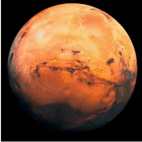Water presence pointed by Mars' minerals
 It has been a long unsolved mystery for the scientists as to how warm and wet Mars once had been. However, they are now viewing global mineralogical signs that suggest the red planet, for the first two billion years of its existence, was at least occasionally wet.
It has been a long unsolved mystery for the scientists as to how warm and wet Mars once had been. However, they are now viewing global mineralogical signs that suggest the red planet, for the first two billion years of its existence, was at least occasionally wet.
The scientists working with data from NASA's Mars Reconnaissance Orbiter reported in an article in the November issue of the journal Geology that a widespread deposits of opals and related minerals on the surface of Mars have been spotted.
They also reported, "Opals belong to a class of minerals known as hydrated silicas, with water molecules wedged into silicon-based minerals like quartz. The formation of hydrated silicas requires liquid water."
The more astonishing fact is that the opal deposits lie in areas that are supposed to have originated only about two billion year ago. Earlier to this discovery, the spacecraft has discovered some other water-bearing minerals like clays in regions that date back more than 3.5 billion years. The age of Mars itself is nearly 4.5 billion years.
Scott Murchie, a staff scientist at Johns Hopkins' Applied Physics Laboratory and the principal investigator for the orbiter's spectrometer, which found the opal evidence, said, "The water was more widespread and extended to younger times."
For many years, the presence of water on Mars has been known through its ice caps that are easily visible from space.. However, one question that remains unanswered is that how often the ice has melted. As of now, the Phoenix Mars Lander, that is nearing the end of its six-month mission is finding out whether the ice has melted in the recent millennia.
It can be quite possible that when Mars was less than a billion years old, it was warm enough for lakes and oceans of liquid water and life too could have existed then.
Maria Zuber, a professor of geophysics at the Massachusetts Institute of Technology said, "The planet's landforms offer compelling evidence for flowing water: immense canyons and channels, dried-up river deltas. I think most people agree there was lots of water on the surface in the first few hundred million years."